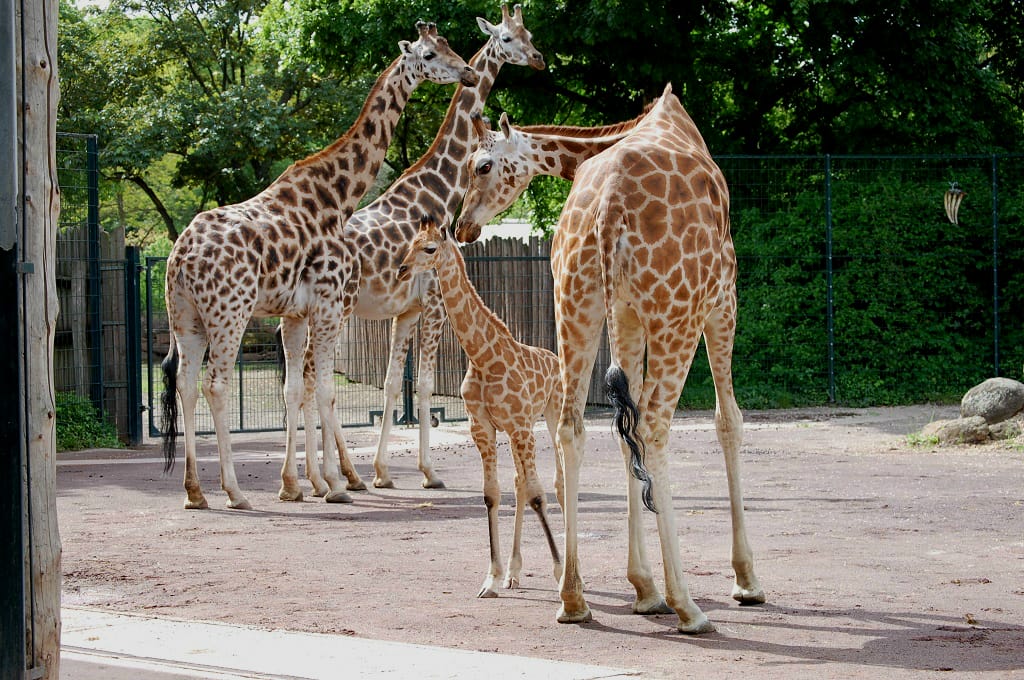
Endangered Status
- According to the International Union for Conservation of Nature (IUCN, 27.01.2018), there are only 1399 Rothschild’s giraffes living in the wild. They are one of the most endangered subspecies of the giraffe.
- On 8.12.2016, the IUCN changed the giraffe status on the red list of threatened species from ‚least concern‘ to ‚vulnerable‘.
- The population of giraffes has decreased by 40% in the last 30 years.
Facts on Rotschild's Giraffes (Giraffe Camelopardalis)
RECORD BREAKERS
- Communication: infrasound (low tones – less than 20Hz)
- Blood pressure is three times higher than a human
- Largest heart of all terrestrial animals, weight of the heart: 11 kg, up to 75 liters of blood is pumped through the bloodstream per minute
- A complex network of arteries in the brain, slows the flow of blood back into the brain, when the giraffe lowers its head and then straightens up again. The arteries work like a sponge so that the blood is soaked up to prevent the uncontrolled blood flow. This is similar to the jugular vein with its extremely strong valves, which slows the speed of blood to the heart.
FACTS ON ROTSCHILD’S GIRAFFES
- Body height: 4.50 m – 5.80 m
- Weight: 500 – 800 kg
- Life span: up to 28 years of age
- Running speed: up to max. 50 km/hour
- Spot pattern: no giraffe has the same pattern as another
- Habitat: savannah, grassland and open woodlands mainly of Uganda
- The giraffe is the tallest mammal and is perfectly adapted to living off trees. With its long tongue, it tears off branches and leaves, even from spiky acacia trees. At this height, the giraffe has no food competitors.
REPRODUCTION
- A giraffe has no particular mating season. Our male giraffe Yoda, who died in 2018, had several mating attempts with Femke until he was successful.
- After a gestation period (pregnancy) of approximately 400 to 460 Tagen (a relatively long period of time), the new born giraffe already has a height of 1,70 m – 1,90 m.
- The new born drinks its mothers milk for roughly a year, but already after a few weeks, the young will start to munch on buds and leaves.
- After about 10 years, a giraffe is fully grown, however a female giraffe is sexually mature after three and a half years and a male giraffe a year later.
HOW MANY VERTEBRAE DOES A GIRAFFE’S NECK HAVE?
Pretty simple – it has seven cervical vertebrae, the same as most mammals (only sirenia/sea cows and sloth vary between 6 and 8 cervical vertebrae). The length of a giraffe’s neck does not come from more vertebrae, rather from the length of the vertebrae. A middle vertebrae can have a length of 35 cm.
HOW LONG IS A GIRAFFE’S TONGUE?
The muscular gripping tongue of a giraffe is roughly 45 centimeters long and its colour is blue/black. The new born also already has a blue/black tongue. With its gripping tongue, the giraffe can grab acacia leaves like a snare. Giraffes are almost constantly eating: approximately 15 hours a day. A giraffe can eat up to 100 kg of food a day. In order for giraffes to eat grass or drink, they must spread their legs wide so that they can reach the ground.
GIRAFFE’S KNOW THE ACACIA TRICK
Acacia branches have thorns, which act like barbed wire covering their leaves. The acacia trees fill their leaves with tannin, which is a highly poisonous substance. However giraffe’s are not bothered by this – they wind their tongues past the thorns in order to get to the leaves. Even the poisonous leaves do not bother the giraffes, as they use their spit to neutralize the poison in their mouthes. Long spit threads are formed. But still the acacia does not give up. As soon as the giraffe begins to munch on the leaves, ants come out of the tree ready to attack. The ants go for the giraffe’s head and neck, trying to bite it. If the ants manage to get to the sensitive areas like inside the nose and the gum area, then even this is too much for the giraffe and it takes leave.
